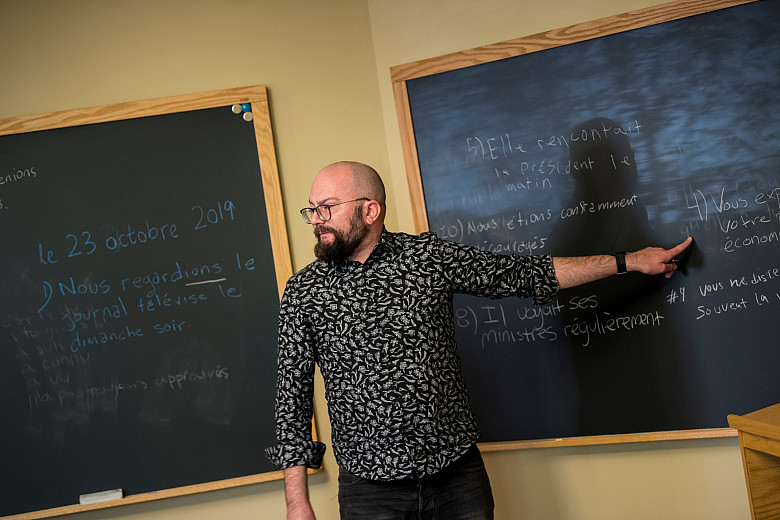Rewriting medieval French literature
Professor of French Joseph Derosier teaches students to dive deep into medieval French romances, asking: How do we connect with literature that was written in a different language, for a different audience, and in a much different time? And how can we reinterpret them as stories that we do understand, like The Office?
Medieval scholar and chair of Beloit’s French department Joseph Derosier asks his upper-level French students to read translations of medieval French romance literature. By reimagining Arthurian legends using modern stories, his students show that these 13th century tales remain relevant in spite of their age.
Stories about King Arthur, the Knights of the Round Table (the namesake of Beloit’s student newspaper), and the Holy Grail circulated widely throughout Europe during the Middle Ages, first in French and then translated into Latin, German, and numerous local languages. Many of these romances depict war and bloodshed during the Crusades, resulting in the conquest of non-Christian groups and the creation of modern ideas of national identity. They display complex courtly intrigue as borders and alliances shift, in addition to graphic scenes of sexual and physical violence.
Even when given its historical context, this content can be difficult to take in. Because the Middle Ages have been reappropriated and decontextualized by modern culture—from video games and Disney movies to the KKK—the task is even more daunting. But Derosier doesn’t ignore this tension. In fact, he encourages his students to grapple with it, says Emily Kratz’21, a double major in political science and French who took Derosier’s medieval literature class during her sophomore year.
“Something that I really enjoyed in his classes is that he doesn’t let you shy away from being uncomfortable,” Kratz says. “If you don’t understand something, he wants you to push on that and figure out why or try to interpret it. The skill that he really focuses on is how do you work through and sit with it.”
One way that Derosier does this is by asking his students to create their own modern reinterpretations of these stories from popular culture. Kratz fondly remembers mimicking the style of Arthurian legends while using the plot and characters of the American iteration of The Office.
“I took the Pam and Jim storyline where they can’t get together in the beginning of the show and used the narrative techniques to rewrite it,” she says. In her version, Jim’s love for Pam transforms him into a telephone so that he can be with Pam forever—while the two remain chaste.
Derosier remembers Kratz’s project as a strong example of applying the themes and concepts of the past to the media of the present. “[Kratz’s creative project] references other tales of transformation and themes of chaste love being eternal and more pure than marital love, [because] true love in these romances is almost never with one’s spouse,” Derosier explains.
Before graduating in May, Kratz took several other classes with Derosier, including one on Maghreban literature (from the former French colonies in Northern Africa) and French New Wave cinema. She says the complex conversations and creative reinterpretations will stick with her.
“[Derosier’s classes] really helped me analyze text because you look at literature from a different perspective. When I’ve taken so many classes with him and done analysis so many times, it starts to become a habit of, ‘How do I look at it this way?’” Kratz adds with a laugh, “Which, if I may be so cheesy, is also the cornerstone of the liberal arts.”



